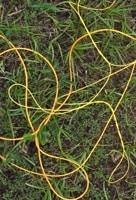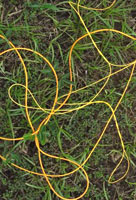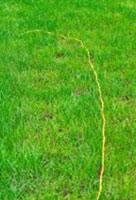
There are a number of reasons why fly-fishermen have trouble with their casting. Most experienced anglers have learned the hard way how to fix or avoid the following common stumbling blocks.
After casting and retrieving for some time, my fly line develops twists.
**
| Inefficient casting most often causes this problem. If you rotate your wrist and hand slightly every time you make a backcast and the rod comes back in a near-vertical position, a partial twist occurs in the line. After many casts, a number of twists will develop.To eliminate this, begin your backcast with the thumb behind the grip and do not turn your wrist. To change the angle of either the backcast or forward cast, move the forearm but be sure to keep your wrist straight. |

|
**
My popping bug doesn’t turn over well.
When you use a streamer, you can see the cast straightening, and unless it’s an unusually air-resistant or heavy fly, a good cast will put it on target. However, when you cast a popping bug, especially a poorly designed one, the leader often collapses at the end of the cast because these flies are so buoyant and wind-resistant.
Three things will correct the problem: 1) shortening the leader – the standard solution – since a long leader can’t maintain enough energy to turn a popper over, 2) replacing the popping bug with one that is better designed and more aerodynamic and 3) increasing the line speed by hauling faster – but don’t add any extra force with your rod hand.
**I have trouble making accurate casts when there is a strong wind from either side.
**This is a common problem on the flats. It is important to understand that the direction the rod tip speeds up and stops in or straightens out at the end of the cast in is the direction the fly travels. Once you stop the rod, you cannot change the direction of the cast.
When there is a strong side wind, you can make an accurate cast by directing the fly at the surface in the target area. Then, as soon at the rod tip speeds up and stops (and your direction is set), drop the rod tip to the water. Your fly travels to the target, and the remainder of the line will be in the water so it can’t blow sideways.
**The more I false-cast, the worse my casting becomes.
**The mark of a good fly-caster is the limited number of false casts he makes. Only one or two are necessary in most situations. One reason many people make too many is that they don’t have enough fly line outside the rod’s tip before starting a backcast. With the right amount, the rod should load on a single backcast and can then be shot at the target.
It’s easy to determine the correct length of line you should have beyond the rod tip. Go to the water and make several backcasts to figure out how much line works best for you, and mark the line at that point. Then tie a five-turn nail knot with 10- or 12-pound-test monofilament at the mark. When you’re retrieving, your fingers will feel that nail knot, indicating it’s time to make the backcast.
When I use a weighted fly I throw a curve to the opposite side from my rod hand at the end of the cast.
This is one of the most common faults of fly-casters. Here’s why and how to eliminate the problem.

| The fly goes in the direction in which the rod tip speeds up and stops at the end of the cast. Many casters develop a tendency to tilt the rod tip out a little further on the forward cast. If you do this and you’re right-handed, the rod tip will bend slightly to the left at the stop, thereby throwing the fly in a curve to the left. For accuracy, the tip must stop in the direction you want the fly to go. You can make a side, angle or vertical backcast, but to avoid throwing a curve, the rod must travel vertically on the forward cast and the tip must stop in the direction of your target.|
**My weighted shooting heads tangle or give me a lot of trouble when casting.
**There are several reasons why heavy heads can be troublesome to cast. They are connected to a thin running or shooting line; the amount of this line that is outside the rod tip and attached to the head is called “overhang.” The length of the overhang is critical to good casting performance. If it’s long, the thin line cannot support the heavy head, and problems arise.
For each fly-angler, line and rod the overhang may differ, but the correct amount can be determined by false-casting the shooting head with very little overhang to start. The head should unroll smoothly in the air at first. Continue false-casting while gradually increasing the amount of running line out of the rod’s tip. You’ll know when it’s too much as soon as waves appear in the head, indicating the thin line can no longer properly turn it over.
At the end of a retrieve, you must make a roll cast to lift the sinking line to the surface for the backcast. If you have difficulty making a good roll cast, you could end up with too much overhang.
Another mistake many casters (even experienced ones) make is to false-cast these lines. The abrupt change in direction, unless very skillfully executed, causes a loss of control. It’s best to make an oval backcast with a shooting head to avoid the abrupt change. If you do make a poor backcast, then instead of continuing, it’s easier and smoother to lightly drop the forward cast and then start over with a better backcast.









